Peru 2010 "Prehistorical animals – Thalassocnus"
| <prev | back to index | next> |
| Issue Date | 21.09.2010 |
| ID | Michel: Bl. 70 (2485); Scott: 1748; Stanley Gibbons: ; Yvert et Tellier: 61; Category: pR |
| Design | Cristian Alvarez M. – SERPOST S.A. |
| Stamps in set | 1 |
| Value | S/. 10.00 -Thalassocnus littoralis: fossil on stamp and reconstruction in margin |
| Emission/Type | commemorative |
| Issue place | Lima |
| Size (width x height) | stamp: 30 mm x 40 mm, Souvenir-Sheet: 80 mm x 100 mm |
| Layout | Souvenir-Sheet with 1 stamp |
| Products | FDC x1 |
| Paper | |
| Perforation | 13.50 x 14 |
| Print Technique | Offset |
| Printed by | Thomas Grag and Sons, Peru |
| Quantity | 10.000 |
| Issuing Authority | Servicios Postales del Peru SA |
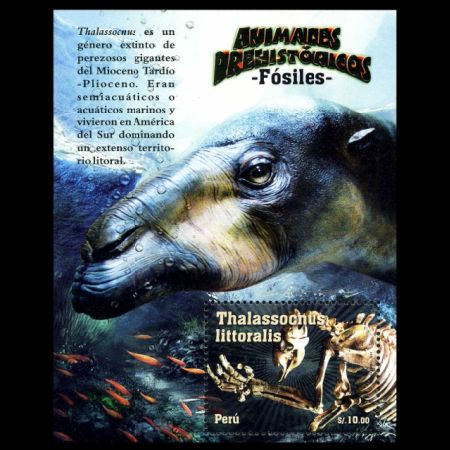
On September 21st, 2010, the Post Authority of Peru - Servicios Postales del Peru SA (Serpost) - continued the series started in 2004, “Prehistoric Animals” (Animales Prehistoricos - Fosiles). These stamps show fossils discovered in the country of Peru.
This year the Souvenir-Sheet shows scientific reconstruction and fossils of a prehistoric sloth - Thalassocnus littoralis.
The reverse side of the Souvenir-Sheet is numbered.
When you think of marine mammals, sloths are probably the last thing you’d expect to take to the water. But from the Late Miocene (7-8 million years ago) to the Late Pliocene (3-1.5 million years ago), several species of giant ground sloths in the genus Thalassocnus did indeed evolve to take advantage of the aquatic environment. However even some modern sloths can swim.
The text below is translation of brochure produced by Serpost in 2010. The text was written by Rodolfo Salas Gismondi, Curator of Vertebrate Paleontology Department of Natural History Museum in Lima (UNMSM).
"If there is something amazing about paleontology it is a capacity to show us that the life on the Earth, such as we know it nowadays, is the result of constant changes.
Even the English naturalist Charles Darwin sketched his primordial ideas about the biological evolution inspired by fossilized bones of giant sloths and Glyptodonts, the ancestors of little tree sloths and armadillos in South America. The theory of evolution developed 150 years ago in Darwin’s “The origin of the species” - is the concept that integrates all the sciences of life, now with the help of genetics and molecular biology. As in Darwin’s time, fossils are still critical to understanding evolution.
After almost 15 years and many discoveries made by Mario Urbina, 5 species of the aquatic sloth Thalassocnus were described, all of them found in marine deposits nearby Sacaco, but in rocks belonging to successive epochs from 9 to 2,5 million years ago.
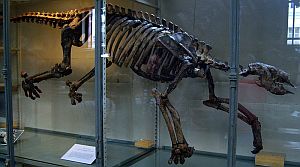 |
| Thalassocnus skeleton - image from Wikipedia, Photographer: FunkMonk. |
In 2008, more work on these fossils was published in the Journal of Vertebrate Paleontology. This work focused on the first remains of Thalassocnus discovered outside of Sacaco, nearly 1500 km away in rocks of marine origin at Bahia Inglesa, in northern Chile. The broadening of the geographic range of these fossils suggests that these animals dominated a vast littoral territory. These fossils were also found with whale and dolphin remains. Another site where Thalassocnus was found recently, was at Ica, 180 km north of Sacaco.
The evolutionary journey of the aquatic sloth, Thalassocnus ended 2 million years ago. The quiet, warm water bays that these animals lived in for millions of years changed to the more agitated seas that we find in this area today. The wide region of sea grass meadows disappeared and the Thalassocnus lineage went extinct. Instead, other terrestrial sloths evolved to become the largest mammals that lived in South America.
Products and associated philatelic items
| FDC | First-Day-of-Issue Postmark | Example of circulated cover |
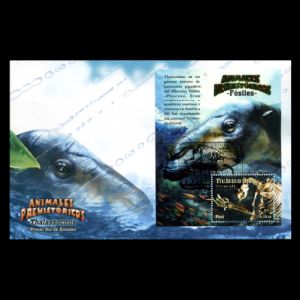 |
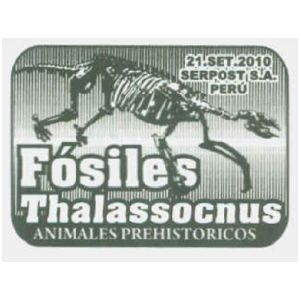 |
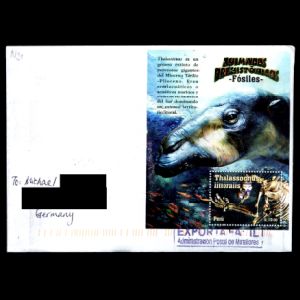 |

|

|
References
- Technical details and stamps presentation:
Serpost Brochure colnect -
Thalassocnus:
Nocturnalsea (the article does not exist anymore) Laalaps -
Museum of Natural History, Lima
official website, Wikipedia
Acknowledgements
- Many thanks to fellow stamp collector Romina Aimar from Argentina, for her help translating Serpost's brochure text from Spanish to English.
- Many thanks to Dr. Peter Voice from Department of Geological and Environmental Sciences, Western Michigan University, for reviewing the draft page and his very valuable comments.
| <prev | back to index | next> |